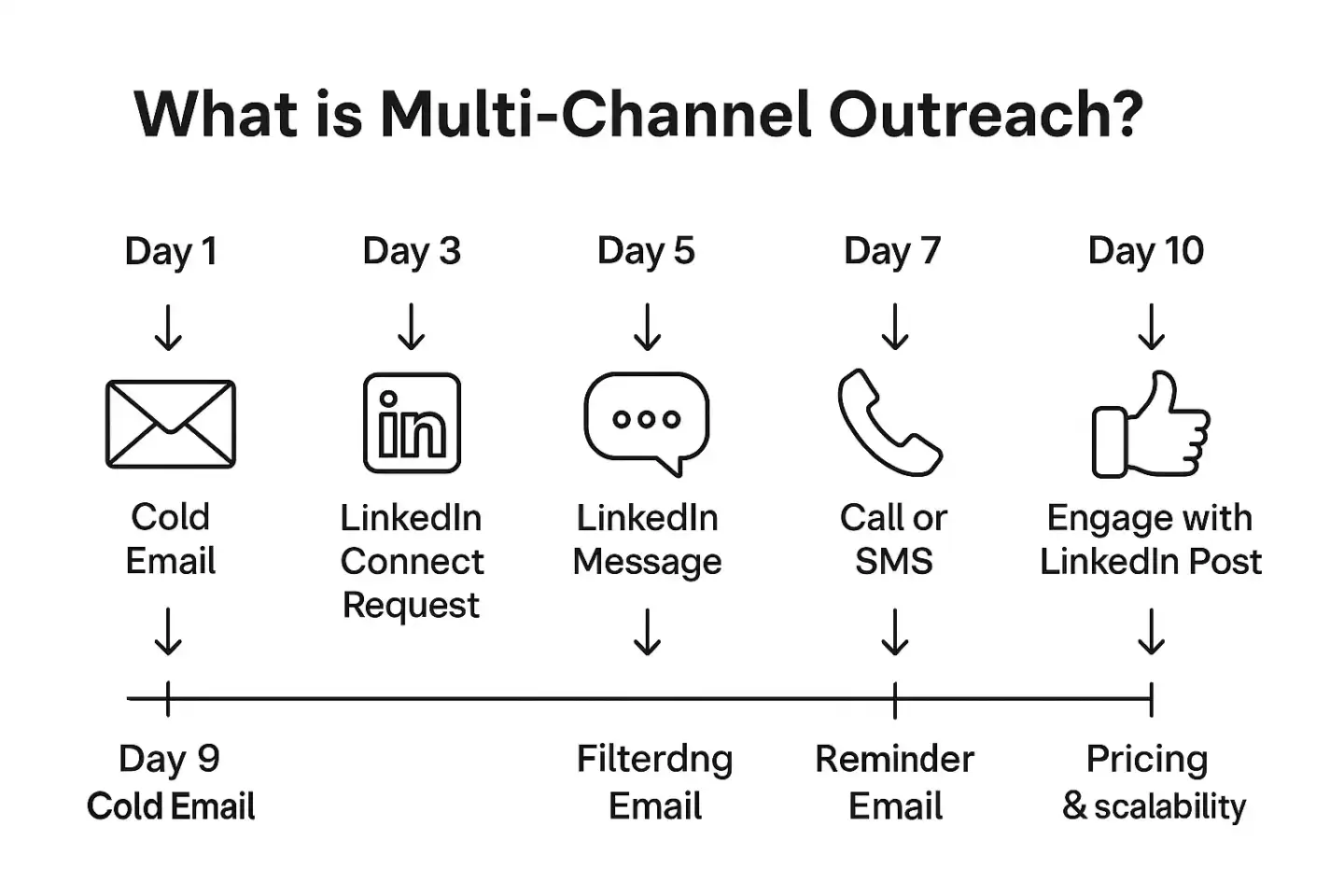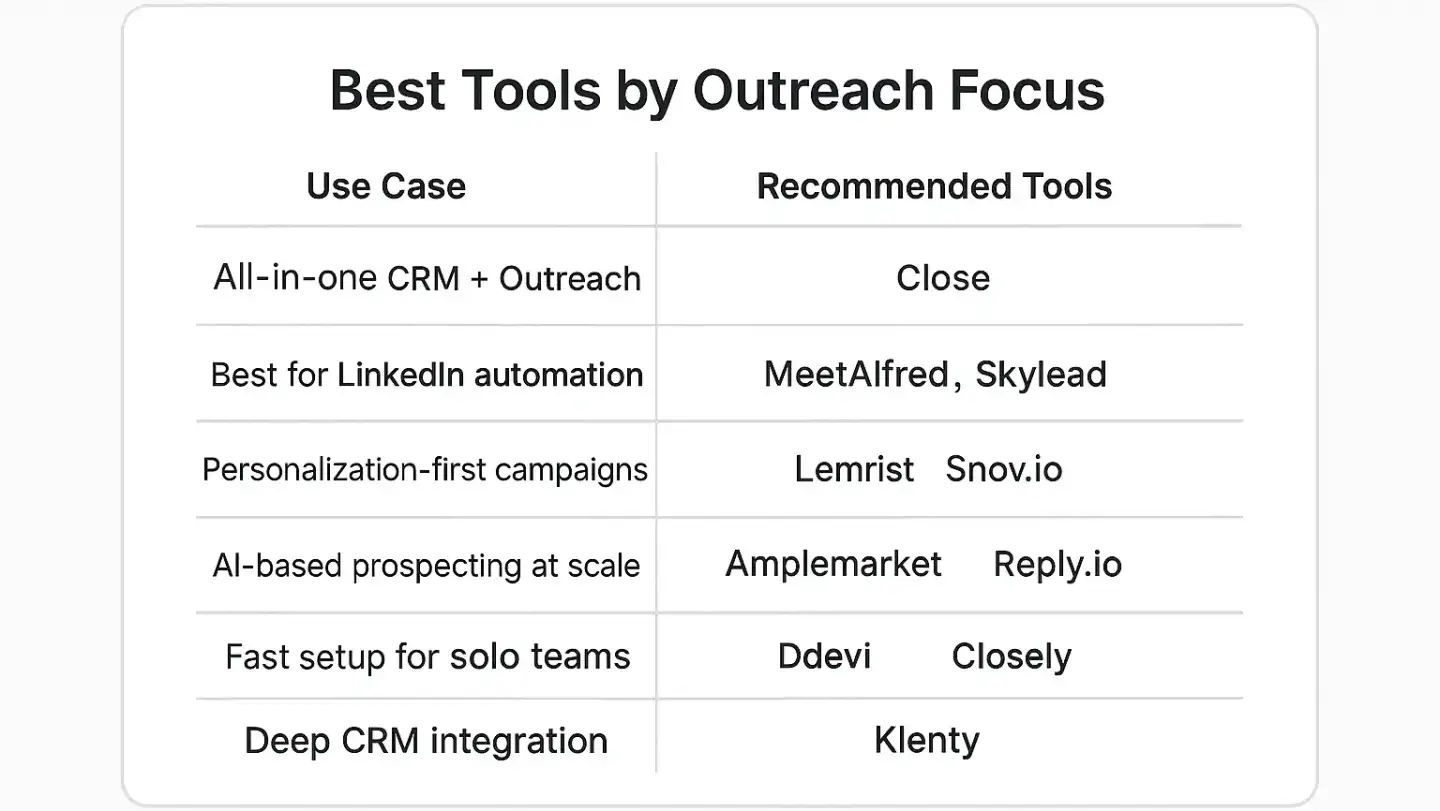We test and review software products using an independent, multipoint methodology. If you purchase something through our links, we may earn a commission. Read about our editorial process.
Cold emails alone no longer cut through the noise. LinkedIn messages get ignored. Even the best ads fall flat without follow-up. In today’s hypercompetitive digital landscape, success in outbound outreach depends on your ability to show up everywhere your potential customers and potential buyers are—email, LinkedIn, phone, social, and beyond, including knowing their job title, as well as understanding the sales funnel, sales pipeline, and overall sales process.
That’s where multi-channel outreach comes in.
It’s not just a buzzword. It’s a data-backed strategy that aligns with modern buyer behavior—where people expect relevance, consistency, and timing across channels.
In this guide, we explain what multi-channel outreach is, why it works, how to choose the best tools, and which platforms lead the market in 2025.
Multi-channel outreach is a strategy that combines multiple communication channels—like cold email, LinkedIn, SMS, phone, and social platforms—to engage prospects at different touchpoints throughout their journey.

Instead of relying on a single message in a single inbox, you create a series of touchpoints across platforms. For example:
Day 1: Cold email
Day 3: LinkedIn connection request
Day 5: Follow-up message on LinkedIn
Day 7: Reminder email
Day 10: Call or SMS
Day 12: Engage with a LinkedIn post
Done right, this method increases reply rates, warms up cold leads, and builds trust faster than single-channel campaigns.
The average B2B buyer receives dozens of professional email addresses and phone numbers daily through an email finder that utilizes advanced search filters to identify potential leads. Their attention is fragmented across platforms. Using only one channel (like email) limits your visibility and increases the chances of being ignored, making it more challenging to connect with prospects in less time.
Multi-channel outreach solves that by:
Increasing visibility: Your name and message appear in multiple contexts
Building familiarity: People respond better when they recognize your name from different channels
Meeting buyers where they are: Some prefer LinkedIn, others email or SMS
Improving deliverability: Fewer emails sent = less chance of being flagged as spam
Improving reply rates: Sequences across 3+ channels typically see 2–3X higher response rates
To find the best multi-channel outreach tools in 2025, we followed our internal software evaluation methodology. This includes:
Channel depth: Number of native outreach channels supported (email, LinkedIn, SMS, WhatsApp, voice, etc.)
Inbox and deliverability: Email warmup, inbox rotation, domain reputation monitoring, crucial for successful email marketing.
Personalization: Options for dynamic content, variables, and custom steps in sequences
Inbox and deliverability: Email warmup, inbox rotation, domain reputation monitoring
CRM integration: Native and Zapier integrations with CRMs, calendars, and enrichment tools, including HubSpot Sales Hub. This sales intelligence platform allows for company size analysis through these integrations, helping users determine the right time to engage.
Analytics: Response rates, step-by-step performance, and A/B testing capabilities
Ease of use: Workflow setup, campaign management, and team collaboration
Compliance: GDPR, CAN-SPAM, and LinkedIn automation policy compliance
Scalability: Fit for both solopreneurs and SDR teams
Snov.io offers a powerful suite of software solutions for cold outreach with multi-channel workflows, including social media integration. It combines email automation, LinkedIn steps, and integrated customer relationship management tools, making it ideal for sales teams that want everything in one platform.
Highlights:
Drag-and-drop sequence builder
Email + LinkedIn + call steps
Email warm-up and verification
Built-in prospecting and enrichment tools
Affordable pricing tiers for startups
Best for: Sales teams that want integrated lead generation and multi-channel automation
Closely is a multichannel sales engagement tool with a focus on email and LinkedIn automation. It supports contact enrichment and LinkedIn campaign management, making it great for B2B lead generation.
Highlights:
LinkedIn auto-connect and follow-ups
Email + LinkedIn hybrid sequences
Contact database with verified B2B leads
Smart inbox and reply detection
Best for: Agencies and LinkedIn-first outreach teams
Klenty stands out for deep CRM integration and sales team features, providing millions of data points for improved efficiency. It supports multi-channel workflows including emails, calls, LinkedIn steps, and tasks synced to your CRM.
Highlights:
Native integrations with Pipedrive, HubSpot, Zoho
SalesPlaybooks for structured outreach
Call dialer and voice mail drops
Behavior-based automation
Best for: Sales teams that work heavily from their CRM
Ddevi is an emerging tool that offers multi-channel outreach with simplicity and speed. It supports email, LinkedIn, and WhatsApp automation with a strong emphasis on deliverability.
Highlights:
Unified inbox for all channels
Fast campaign setup
Real-time delivery tracking
Affordable for small teams
Best for: Solo founders and startups looking for lean multi-channel campaigns
Close is a full CRM with built-in outreach automation, including email, calls, SMS, and tasks. It's not a lightweight tool—it’s a full sales OS for high-velocity teams.
Highlights:
All-in-one CRM and outreach engine
VoIP and SMS built-in
Sequences across email, call, SMS
Advanced analytics and reporting
Best for: Sales teams that want CRM and multi-channel outreach in one
Lemlist is known for high-deliverability cold emails, but its multi-channel workflows (email + LinkedIn + calls) are now just as impressive for converting website visitors. Its personalization features are best-in-class.
Highlights:
Highly visual campaign builder
Hyper-personalization (images, videos, custom text)
Lemwarm email warm-up engine
Email + LinkedIn + call steps
Best for: SDRs and cold email pros who care about personalization
Skylead automates both email and LinkedIn with smart sequences that adapt based on user actions. It includes detailed analytics and allows dynamic branching.
Highlights:
Email + LinkedIn + InMail automation
Smart conditions (e.g., if connected → send message)
Built-in prospecting
Cloud-based architecture
Best for: Growth hackers and SDRs focused on personalization
Reply.io is a robust platform for multi-channel outbound, combining cold email, LinkedIn, SMS, WhatsApp, and calling, including an effective email sequence. Its AI features help score leads and suggest responses.
Highlights:
Multichannel sequencing
AI-based lead scoring and writing assistant
Email verification, warm-up, and A/B testing
Deep analytics and team collaboration features
Best for: Scale-ups, agencies, and teams doing high-volume outreach
MeetAlfred focuses on LinkedIn automation but also supports email and Twitter for multi-channel campaigns. It includes team collaboration and analytics tools for agencies.
Highlights:
LinkedIn + email + Twitter automation
CRM and lead database
Calendar and drip campaign scheduler
Performance reports and templates
Best for: Social-first agencies and small B2B teams
Amplemarket offers an AI-powered outbound platform with sequencing across multiple channels to generate qualified leads. It includes a lead database, enrichment, and intent-based targeting.
Highlights:
Email, LinkedIn, and phone steps
Smart lead targeting and AI suggestions
High inbox deliverability
Enrichment and verification built-in
Best for: Enterprise SDRs and growth teams needing intelligence + scale
Multi-channel outreach is no longer optional—it’s essential
The days of one-size-fits-all cold emails are over
Today, prospects expect relevant, timely, and cross-platform engagement
By combining email, social, and other touchpoints, the tools listed above give you a competitive edge in outbound sales

Key takeaways:
Start simple (email + LinkedIn) and expand
Focus on relevance, not spammy volume
Choose tools that match your tech stack and team size
Use automation to scale—but keep the human touch
Whether you're a solo founder or a team of SDRs, the right multi-channel outreach platform helps you start more conversations, enhance your outreach efforts, book more meetings, and close more deals.
Let me know if you'd like a comparison infographic or metadata for this guide
To ensure alignment, start by conducting a thorough needs assessment within your organization. Engage with different departments to understand their unique requirements and expectations.
During the evaluation phase, prioritize features that directly address these needs and consider seeking feedback from potential end-users to guarantee a user-friendly and tailored solution.
Data security is paramount in the selection process. Choose a prospector tool with robust security features, including encryption, access controls, and compliance with relevant regulations.
Additionally, vet the vendor's track record, inquire about their data protection policies, and ensure they follow industry best practices to safeguard sensitive information, maintaining the integrity and trustworthiness of your data.
Opt for a prospector tool that demonstrates a commitment to innovation and scalability. Look for features like regular updates, integration capabilities with emerging technologies, and a vendor with a history of adapting to industry trends.
Engage with the vendor regarding their roadmap for future development to ensure your chosen tool remains a strategic asset as technology continues to advance.